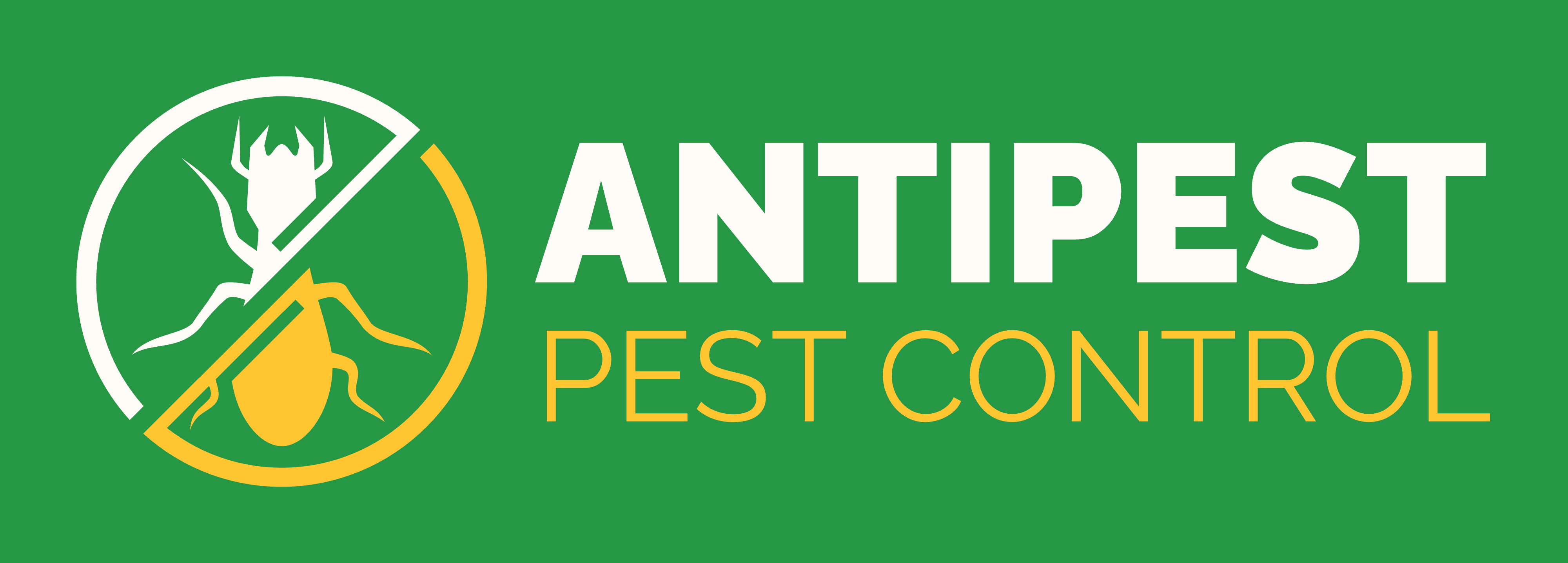Spider mites might be tiny, but their impact on your plants, indoors and outdoors, is far from small. If you’ve noticed fine webbing, yellow speckles on leaves, or suspect your plants are under attack, understanding how to get rid of spider mites is urgent and empowering. Whether you’re a passionate gardener or a devoted plant parent, knowing effective spider mite removal strategies ensures your greenery stays vibrant and healthy.
Discovering how to get rid of spider mites means learning about detection, targeted treatments, and ongoing prevention to stop infestations before they escalate. This guide covers insights from horticulture experts, actionable DIY techniques, and tips for lasting plant protection, all presented in a format designed to answer your common questions and equip you with reliable solutions.
Table of Contents
Understanding Spider Mite Infestations
Spider mites thrive in warm, dry conditions and can reproduce rapidly, causing significant leaf damage. Recognizing the early signs is critical for addressing how to get rid of spider mites efficiently.
Key Symptoms:
- Fine webbing across stems and leaf joints.
- Stippling or yellowing spots on leaves.
- Leaves curling, drying, or dropping prematurely.
Mites are exceptionally tiny, often visible only as small moving dots. Examine the undersides of leaves with a magnifying glass for clarity. Early vigilance is foundational for successful removal.
Best Practices for Immediate Spider Mite Removal
No single solution works for every situation, so integrating multiple methods is the most effective approach for tackling how to get rid of spider mites.
| Treatment Option | Application Steps | Expected Outcome |
| Water Spray | Hose or spray leaves (undersides too) to dislodge mites | Physical removal, lower count |
| Insecticidal Soap | Spray plants thoroughly; repeat every 7-10 days | Breaks mite exoskeletons |
| Neem Oil Solution | Mix and spray on all leaf surfaces, avoiding peak sun | Smothers pests, long-acting |
| Rubbing Alcohol Mix | Dilute and apply with a cotton swab or spray bottle | Rapid kill, spot-targeting |
| Miticides | Rotate selective chemicals (abamectin, bifenazate, spiromesifen) | Strong action, for outbreaks |
Always test new sprays on a single patch of plant before widespread application, some leaves are sensitive, especially to alcohol and certain soaps.
| Early Warning Signs | Advanced Infestation |
| Fine webbing on leaf undersides | Dense webbing covering entire plants |
| Tiny yellow or bronze spots on leaves | Extensive leaf discoloration and browning |
| Stippled appearance on foliage | Premature leaf drop |
| Small moving dots visible under magnification | Plant stunting and death |
How to Get Rid of Spider Mites from Plants?
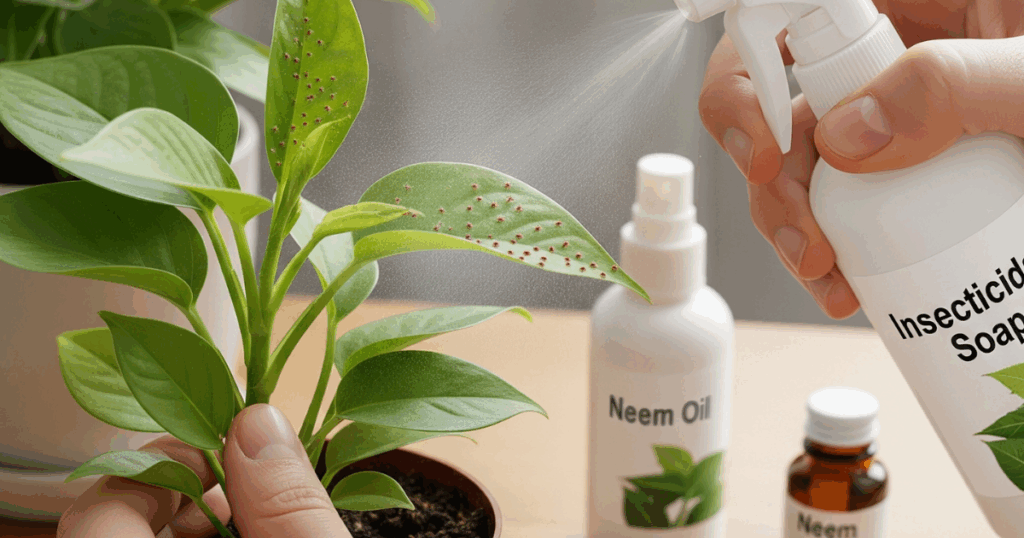
Immediate action saves plants from extensive damage.
| Action | How It Helps | Frequency |
| Spray with water | Dislodges mites, webs | Weekly or as needed |
| Insecticidal soap | Breaks mite exoskeletons | Every 7–10 days |
| Neem oil spray | Smothers and kills all life stages | Every 7 days |
| Rubbing alcohol mix | Spot-kills mites on leaves | As required |
- Spray plants thoroughly with room temperature water to physically remove mites and webs.
- Use insecticidal soaps or neem oil for effective pest control; always cover leaf undersides and repeat treatments to disrupt life cycles.
- Rubbing alcohol (dilute 1 cup in 4 cups water) or gentle dish soap (1 tablespoon/liter water) helps kill visible pests, but always patch test first.
- Isolate infested plants to prevent spread to healthy ones.
Signs Your Plants Have Spider Mites
| Symptom | Cause | Next Steps |
| Fine webbing | Spider mites | Inspect, apply treatments |
| Yellow speckles | Feeding damage | Confirm with magnification |
| Leaf drop/curling | Advanced attack | Water, treat mites urgently |
| Plant stagnation | Stress from pests | Boost humidity, monitor health |
How to Get Rid of Spider Mites in Soil?
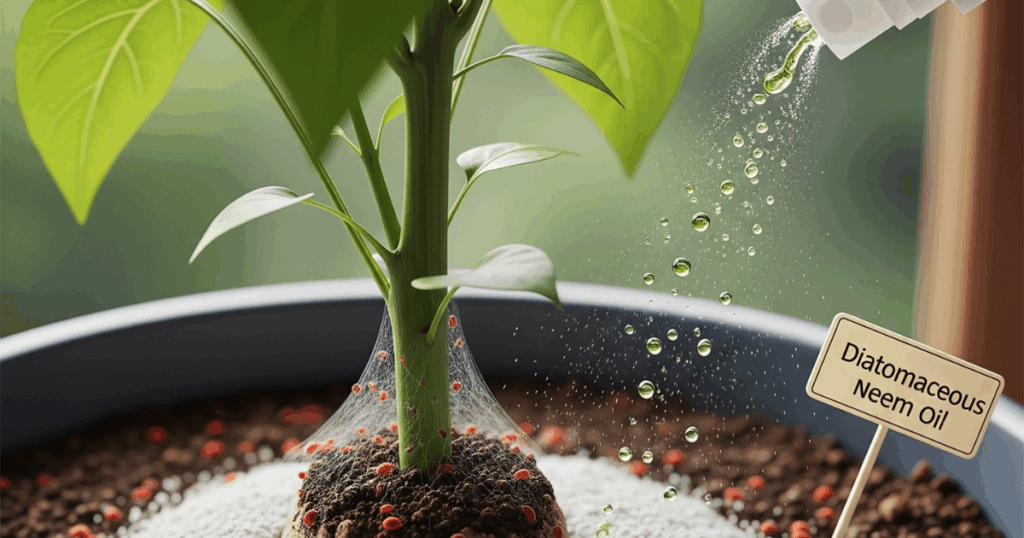
While spider mites primarily live on plant foliage, understanding how to get rid of spider mites in soil addresses the overwintering stages and soil-dwelling phases of their life cycle. Female spider mites often overwinter in soil debris, plant residue, and protected areas around plant bases.
Soil Treatment Strategies:
- Fall cleanup: Remove all plant debris and fallen leaves where mites overwinter
- Soil cultivation: Light cultivation in early spring disrupts overwintering sites
- Beneficial nematode application: Release predatory nematodes that target soil-dwelling pests
- Organic matter addition: Healthy soil supports beneficial organisms that compete with pests
Seasonal Soil Management
Spring soil preparation significantly impacts spider mite populations throughout the growing season. Remove overwintering debris, add compost to improve soil health, and maintain proper soil moisture to create conditions favoring beneficial organisms over pest species.
How to Get Rid of Spider Mites During Flowering?
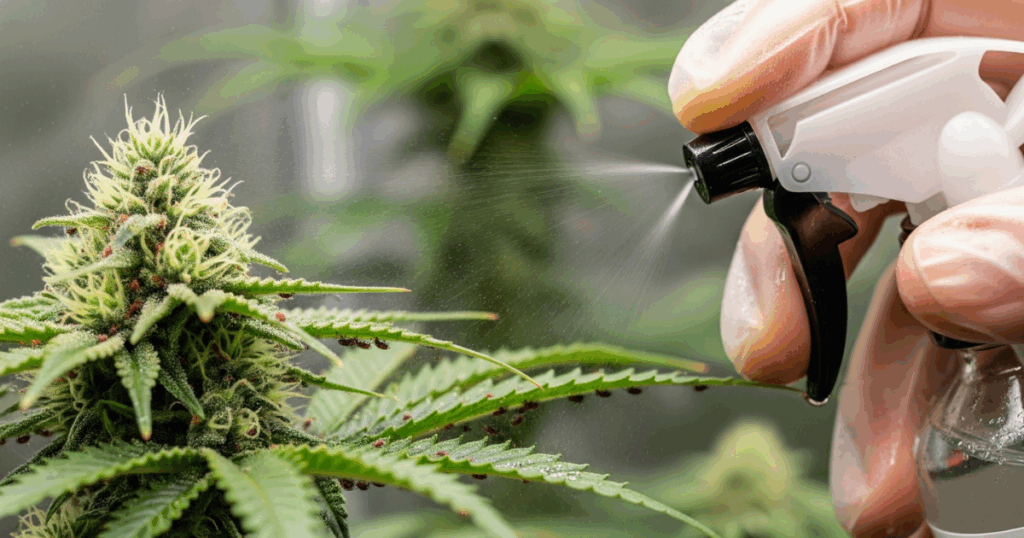
Understanding how to get rid of spider mites during flowering requires careful treatment selection to avoid damaging flowers or affecting fruit development. During this critical growth stage, plants are more sensitive to treatments, and some control methods may interfere with pollination or fruit set.
Treatment Timing During Flowering
Apply treatments during early morning or evening hours when pollinators are less active. Avoid spraying open flowers directly, focusing treatments on foliage and stems where spider mites typically congregate. This targeted approach protects beneficial insects while maintaining pest control effectiveness.
Safe Flowering Stage Treatments:
- Water sprays: Gentle pressure on foliage only, avoiding flowers
- Beneficial insect releases: Predatory mites work without interfering with pollination
- Selective soap applications: Target leaf undersides and stems, avoiding blooms
- Essential oil treatments: Light applications during non-pollinator hours
Monitor plants closely during flowering as stress from spider mite feeding can significantly impact flower and fruit production. Early intervention becomes even more critical during this vulnerable growth stage.
| Solution | Use During Flowering? | Safety |
| Water spray | Yes | Gentle, effective |
| Neem oil/soap | Yes, test first | Avoid direct bud contact |
| Hydrogen peroxide | Sometimes, dilute well | Use carefully, spot treat |
| Beneficial mites | Yes | Safe, effective |
How to Get Rid of Spider Mites Naturally?
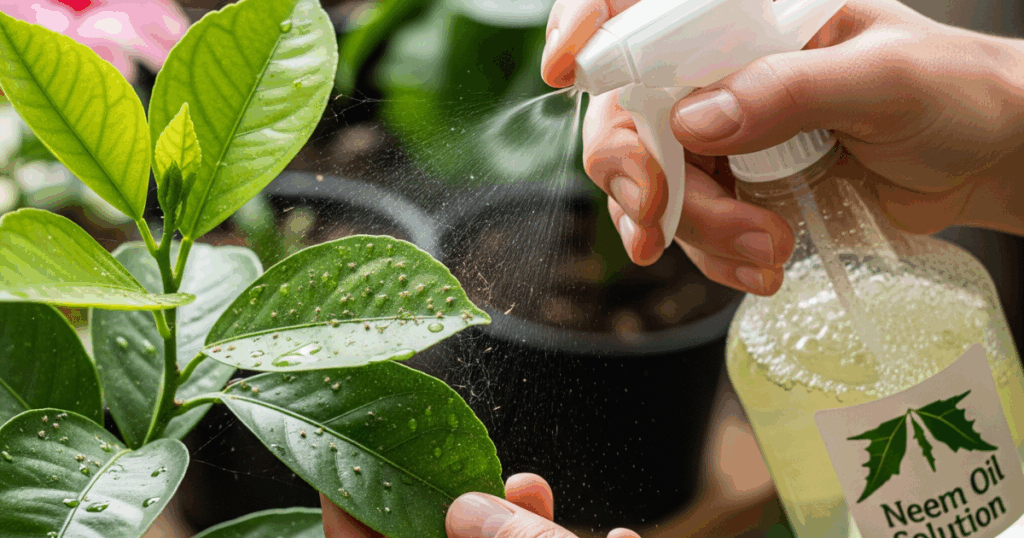
Natural remedies are safe for people, pollinators, and pets.
- Neem oil mixed with water and a few drops of castile soap is highly effective, apply during cooler hours and wipe residue after a while.
- Insecticidal soap made with gentle dish soap kills mites safely.
- Rubbing alcohol diluted with water can be sprayed or applied with cotton swabs for spot treatments.
- Garlic, rosemary, peppermint, or cinnamon teas may help repel mites.
- Release natural predators: Phytoseiulus persimilis and ladybugs are enthusiastic mite hunters.
Spider Mite Remedies and Efficiency
| Remedy | Plant Suitability | Effectiveness | Safety |
| Water spray | All | Instant | Very safe |
| Neem oil | Most, not all | High | Patch test on leaves |
| Insecticidal soap | All | High | Safe for most plants |
| Rubbing alcohol | Houseplants, roses | Medium-High | Test, avoid root contact |
| Sulfur dust | Tomatoes | High | Use with care |
| Beneficial insects | Outdoor | High | No chemicals required |
How to Get Rid of Spider Mites on Houseplants?
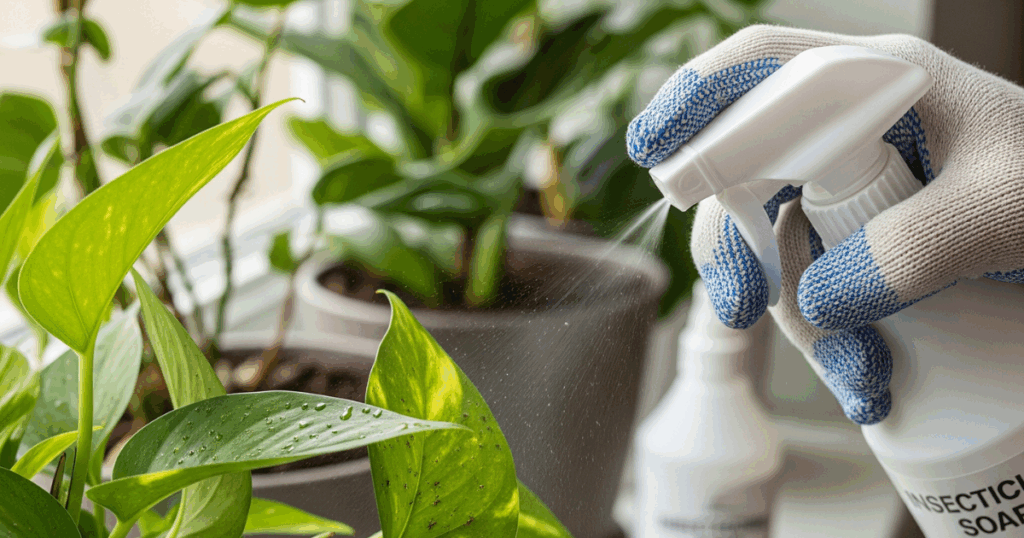
Houseplants are vulnerable to spider mites, especially in dry, heated indoor environments.
- Isolate infected houseplants immediately.
- Spray leaves and stems with water to remove mites and webbing.
- Wipe leaves gently with diluted rubbing alcohol, being careful not to oversaturate the soil.
- Regularly mist plants to maintain humidity and discourage mites.
- Monthly preventive sprays with insecticidal soap keep infestations from recurring.
Spider Mite Removal by Plant Type
| Plant Type | Best Natural Treatment | Notes |
| Houseplants | Neem oil, water spray | Isolate, repeat weekly |
| Roses | Insecticidal soap, alcohol | Spray in morning/evening, avoid sun |
| Tomato plants | Neem oil, sulfur dust | Thorough leaf underside treatment |
How to Get Rid of Spider Mites on Roses Naturally?
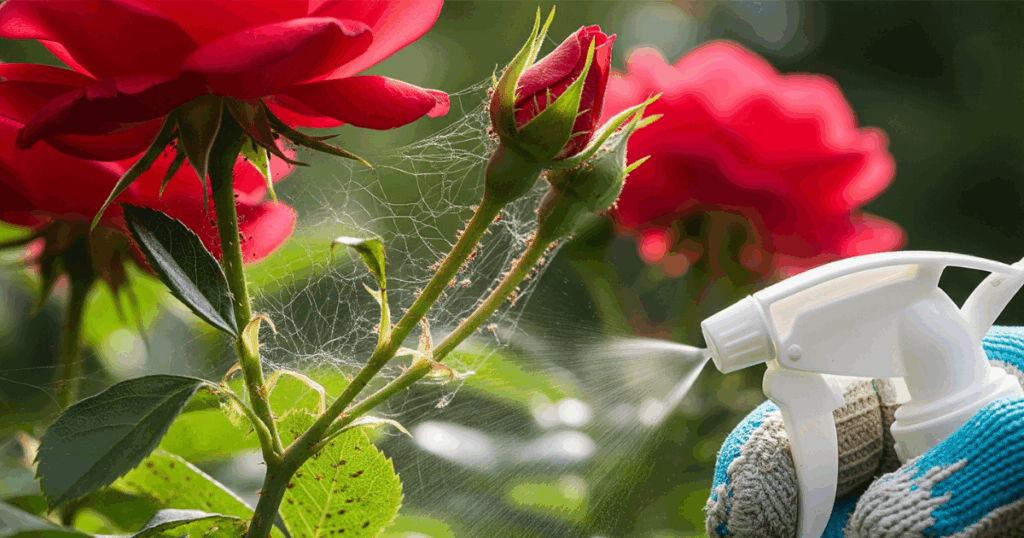
Learning how to get rid of spider mites on roses naturally requires understanding the unique characteristics of rose plants and their susceptibility to mite infestations. Roses are particularly attractive to spider mites due to their dense foliage and the warm microclimates created around rose bushes.
Natural Rose Treatment Protocol:
- Morning water spray: Use hose attachment to spray rose foliage thoroughly
- Neem oil application: Apply every 10-14 days during growing season
- Beneficial insect habitat: Plant companion plants that attract predatory insects
- Mulching: Maintain soil moisture and reduce plant stress
Companion Planting for Rose Spider Mite Control:
Plant herbs and flowers that naturally repel spider mites around rose beds. Effective companion plants include:
- Dill and fennel: Attract beneficial insects that prey on spider mites
- Marigolds: Natural pest deterrent properties
- Chives and garlic: Strong aromatic compounds repel many pests
- Yarrow: Attracts predatory insects while improving soil health
Rose Care During Treatment
Maintain consistent watering schedules and proper fertilization to keep roses healthy and resistant to spider mite establishment. Stressed roses become more susceptible to pest infestations, making preventive care as important as active treatment methods.
How to Get Rid of Spider Mites on Tomato Plants?
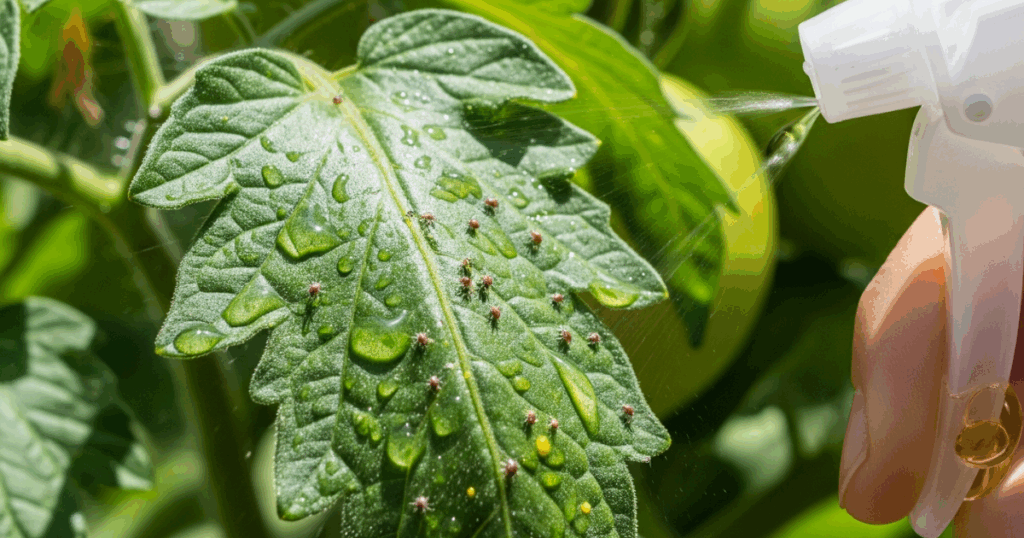
Understanding how to get rid of spider mites on tomato plants involves addressing the specific growing conditions and plant characteristics that make tomatoes vulnerable to spider mite infestations. Tomato plants’ dense foliage and preference for warm, sunny locations create ideal spider mite habitat.
Integrated Tomato Spider Mite Control:
- Cultural controls: Proper spacing, adequate irrigation, and mulching
- Biological controls: Release predatory mites early in the growing season
- Mechanical controls: Regular water spraying and removal of heavily infested leaves
- Organic treatments: Neem oil and insecticidal soap applications
Critical Timing for Tomato Treatment:
Early season prevention proves most effective for tomato spider mite control. Begin monitoring when plants reach 12-18 inches in height, as this stage marks increased susceptibility to infestations.
| Growth Stage | Treatment Focus | Recommended Methods |
| Seedling | Prevention | Proper spacing, humidity control |
| Vegetative | Early detection | Weekly monitoring, water sprays |
| Flowering | Gentle treatment | Beneficial insects, selective applications |
| Fruiting | Continued vigilance | Maintain beneficial populations |
Natural and Biological Solutions for how to get rid of spider mites?
Many gardeners and plant enthusiasts prefer organic or low-impact methods for how to get rid of spider mites, supporting both plant health and environmental safety.
Natural Sprays and Home Remedies
Natural remedies can be surprisingly effective, especially for minor infestations or regular prevention.
- Neem Oil: Mix with water and spray in cooler hours for best results. Neem suffocates spider mites and disrupts their reproductive cycle.
- Insecticidal Soap: Easily prepared at home using mild liquid soap and water. Spray thoroughly on both sides of the leaves.
- Rubbing Alcohol: Mix 1 cup with 4 cups of water. Spray or wipe leaves, but always patch test first.
- Herbal Mixes: Solutions with peppermint, rosemary, or garlic can repel or kill mites. Some gardeners swear by cinnamon-clove teas.
| Remedy | Ingredients | Frequency | Target |
| Neem Oil | Neem oil, water | Every 7 days | All life stages |
| Insecticidal Soap | Mild soap, water | Every 7-10 days | Adult mites |
| Rubbing Alcohol | Alcohol, water | Weekly | Visible pests |
Beneficial Predators Biological Solutions
Leveraging natural predators is a smart, eco-friendly way to keep spider mites in check.
Encouraging beneficial insects provides sustainable long-term control for spider mite populations. Natural predators offer biological control that works continuously without chemical inputs or resistance development. Key beneficial species include:
Primary Spider Mite Predators:
- Ladybugs: Consume both adult mites and eggs
- Lacewing larvae: Aggressive predators of all mite life stages
- Predatory mites: Amblyseius andersoni and other species provide specialized control
- Thrips: Certain species prey on spider mites while avoiding plant damage
Chemical Treatments and When to Use Them
When learning how to get rid of spider mites through chemical means, horticultural oils and specialized miticides provide the most effective control for severe infestations. Both petroleum-based and plant-based oils (neem, canola, cottonseed) work by suffocating mites and disrupting their life cycle.
Dormant oils applied during fall and spring target overwintering eggs and dormant adults, while summer horticultural oils control active populations. Apply oils thoroughly to ensure contact with mites, as these products work only through direct contact with pests.
Professional Miticide Applications
Specialized miticides designed specifically for mite control offer superior results compared to general insecticides. Most spider mites show resistance to standard insecticides, making miticide selection crucial for effective control. Professional-grade options include:
| Miticide Type | Active Ingredient | Application Notes |
| Abamectin | Avid® | Systemic action, 5-7 day effectiveness |
| Bifenazate | Floramite® | Contact and residual control |
| Hexythiazox | Hexagon® | Disrupts egg and larval development |
| Spiromesifen | Forbid® | Long-lasting residual protection |
Rotate between different active ingredients to prevent resistance development, and monitor treatment effectiveness within five to seven days. If populations persist after proper application, switch to a miticide with a different mode of action rather than repeating the same treatment.
Preventing Future Spider Mite Infestations
A big part of how to get rid of spider mites is keeping them from coming back. Maintenance routines make recurrence less likely.
- Increase Humidity: Spider mites hate moisture. Mist plants regularly or use a humidifier indoors.
- Quarantine New Plants: Isolate new arrivals for 30–40 days to catch infestations early.
- Regular Cleaning: Wipe leaves and check underside weekly. Remove dust, webs, and debris.
- Healthy Growing Conditions: Avoid over-fertilizing, congested planting, or letting soil dry out for long stretches.
| Prevention Strategy | Details | Frequency |
| Mist leaves | Increases humidity | 2-3 times/week |
| Clean foliage | Wipe with damp cloth | Weekly |
| Check new plants | Isolate and inspect | 1 month |
| Rotate treatments | Alternate methods | As needed |
Complete Action Plan on How to Get Rid of Spider Mites?
A clear plan for how to get rid of spider mites combines physical removal, targeted treatments, and consistent monitoring.
| Step | Actions | Frequency | Tools Needed |
| Inspect plants | Check leaves, stems | Weekly | Magnifying glass |
| Water blast | Spray undersides, remove webs | Biweekly | Hose, spray bottle |
| Apply remedy | Neem, soap, alcohol | Weekly | Spray bottle, cloth, swab |
| Release predators | Ladybugs, predatory mites | Monthly | Purchased insects |
| Repeat cycle | Alternate methods | Throughout | Varied |
| Preventative care | Humidity, quarantine | Ongoing | Humidifier, isolation space |
Staying persistent and combining methods will put you ahead in the fight against spider mites.
Spider Mite Remedies and Effectiveness
| Control Method | Speed of Results | Safety for Plants | Lasting Effect | Ease of Use |
| Water Spray | Fast | High | Short-term | Easy |
| Insecticidal Soap | Moderate | High (most plants) | Medium | Easy |
| Neem Oil | Moderate | High (most plants) | Long-term | Medium |
| Rubbing Alcohol | Fast | Test before use | Medium | Easy |
| Miticides | Fast/Moderate | Variable | Medium/Long | Medium |
| Predatory Insects | Moderate | High | Long-term | Medium |
Common Mistakes to Avoid
Understanding how to get rid of spider mites means recognizing and avoiding common missteps.
- Ignoring the undersides of leaves, where mites hide and lay eggs.
- Using regular insecticides instead of specific miticides.
- Overwatering or underwatering plants, which weakens their natural defenses.
- Failing to maintain cleaning and humidity after initial eradication.
- Overapplying harsh chemicals, risking plant damage or resistance build-up.
By steering clear of these mistakes, your spider mite strategy will be all the more successful.
Conclusion
Getting rid of spider mites isn’t a one-time event, it’s a process that combines vigilance and proactive care. By learning how to get rid of spider mites, employing integrated methods, and maintaining healthy plant environments, you’ll not only manage present infestations but discourage new ones. The journey to discovering how to get rid of spider mites empowers you to enjoy lush, pest-free plants for years to come.
For comprehensive and hassle-free spider bites removal and long-term pest prevention, trust the professionals at Antipest Office. Our trained technicians use safe and effective methods to protect your home and business. For service bookings and consultations, call us at +91 9819018398 .
How to Get Rid of Spider Mites? – FAQs
How to get rid of spider mites on plants quickly?
Spray leaves with water, apply neem oil or insecticidal soap, covering both sides of leaves, and repeat weekly until mites are eliminated.
How to get rid of spider mites in soil effectively?
Remove and replace the topsoil, introduce beneficial nematodes, and maintain proper watering to keep soil conditions unfavorable for mites.
How to get rid of spider mites during flowering without harming blooms?
Use gentle water sprays, prune infested leaves, and apply mild neem oil carefully, avoiding direct contact with flowers and buds.
How to get rid of spider mites naturally at home?
Apply neem oil, insecticidal soap, and diluted rubbing alcohol, or release predatory insects like ladybugs for safe, chemical‑free control.
How to get rid of spider mites on houseplants indoors?
Isolate infected plants, spray with water, wipe leaves with diluted rubbing alcohol, and increase humidity to discourage mites.
How to get rid of spider mites on roses naturally?
Spray with water under leaves, apply insecticidal soap, use diluted rubbing alcohol, and encourage predators like lacewings.
How to get rid of spider mites on tomato plants safely?
Treat with neem oil or sulfur dust, spray with water to remove mites, and release ladybugs for natural control.
How to get rid of spider mites using insecticidal soap?
Mix mild liquid soap with water, spray plants thoroughly, especially leaf undersides, every 7–10 days until mites are gone.
How to get rid of spider mites and stop them from returning?
Increase humidity, clean leaves regularly, isolate new plants, and rotate treatments to prevent resistance.
How to get rid of spider mites using beneficial insects?
Release predatory mites, ladybugs, or lacewings in affected areas, they feed on spider mites, reducing populations naturally over time.

